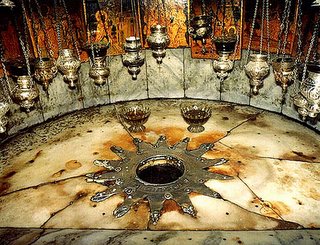 What I Saw In The Holy Land, Part I
What I Saw In The Holy Land, Part IThis is the Church of the Nativity in Bethlehem, one of three churches constructed by Constantine & St. Helen in 326 to protect the holy sites of Christendom --albeit what you're looking at now was constructed by Justinian 200 years later after the original church was all but destroyed. Then the Crusaders built a monastery around the north side of the Church in the 12th century (if the portion of the Church in the left of this photo extended left a bit more, you could see it). See that tiny entrance in the wall at the back left? That's the "gate of humility," which all but sealed the original spacious entrance to the Church in the 16th century --to prevent Muslims from riding horses into the church to plunder and destroy.
Bethlehem --both the city and the site-- will break your heart. As you approach it by bus heading slightly southeast from Jerusalem, the countryside looks just the way you expect it to --the way you see it every year in "O Little Town of Bethlehem" Christmas cards. At a certain point, however, the city disappears behind the Israeli Security Wall: the Wall of Shame as the Arabs call it. (I'll address the wall in my next post.)
Once you pass the security checkpoint and disappear behind the wall, the standard of living in your surroundings drops dramatically. You find yourself officially in a third world, backwater little town. Your bus parks at the lot, and you walk up to see the Church pretty much as you see it in this photo, with a huge empty square (but for about 10 vendors aggressively selling postcards & knicknacks).
The Italians have an expression about the city of Naples: "bello e bruto." The phrase sprang to mind here. The "bello" is the fascination of the layers of history preserved in the various incarnations of the Church: the crusader crosses, the perfectly preserved and intricate mosaic floors of the Byzantine period. And a magic little word: "Hic." All over the world Christians commemorate the birth of Christ, the mystery of the Incarnation, with the words, "The Word was made flesh." Only in Bethlehem the Latin inscription reads Here the Word was made flesh. It's a powerful experience to stand in the very place.
The "bruto" is that your eyes long to see the place as it was. The humble cave, the plain spot. What you actually see is this. And why do there have to be 15 lamps burning? Six for the
 Greeks, five for the Armenians, four for the Latins. And the Latins can't celebrate Mass at the actual site of Christ's birth, though they are permitted to bring an image of the Baby Jesus in procession to the crib at Christmastime.
Greeks, five for the Armenians, four for the Latins. And the Latins can't celebrate Mass at the actual site of Christ's birth, though they are permitted to bring an image of the Baby Jesus in procession to the crib at Christmastime.
This spot is under an altar, so you have to kneel to see it, and behind it and slightly to the right is a little chapel where the Magi are said to have venerated Christ. It's an astonishing thing to contemplate at one and the same time the mystery of God's love for us and the reality of sin --such that Christians, called to give witness to God's love in the world-- can't even resolve their differences. In his high priestly prayer at the last supper (John 17), Jesus prayed to his Father that all his followers would be one "that the world may know that you sent me, and that you loved them even as you loved me." If Christ says that Christian unity is to be the sign to the world that he is who he says he is, is it any wonder the world has lost its faith? Can Muslims & Jews be expected to get the message when Latin & Greek Christians can't? John Paul II used to say the Church must learn once again to breathe with both lungs. At Bethlehem, the fact that it doesn't becomes positively painful. One holy site, and there are three convents erected over the top of it, because the Christians can't pray together.
And just to add to the welter of mixed emotions you have, the muzzein will probably start chanting very loudly during your Mass from the minaret across the street. The Muslims have set up minarets as close to all the Christian and Jewish holy sites as they can, and they point the loudspeakers right at you just in case you miss the message.

